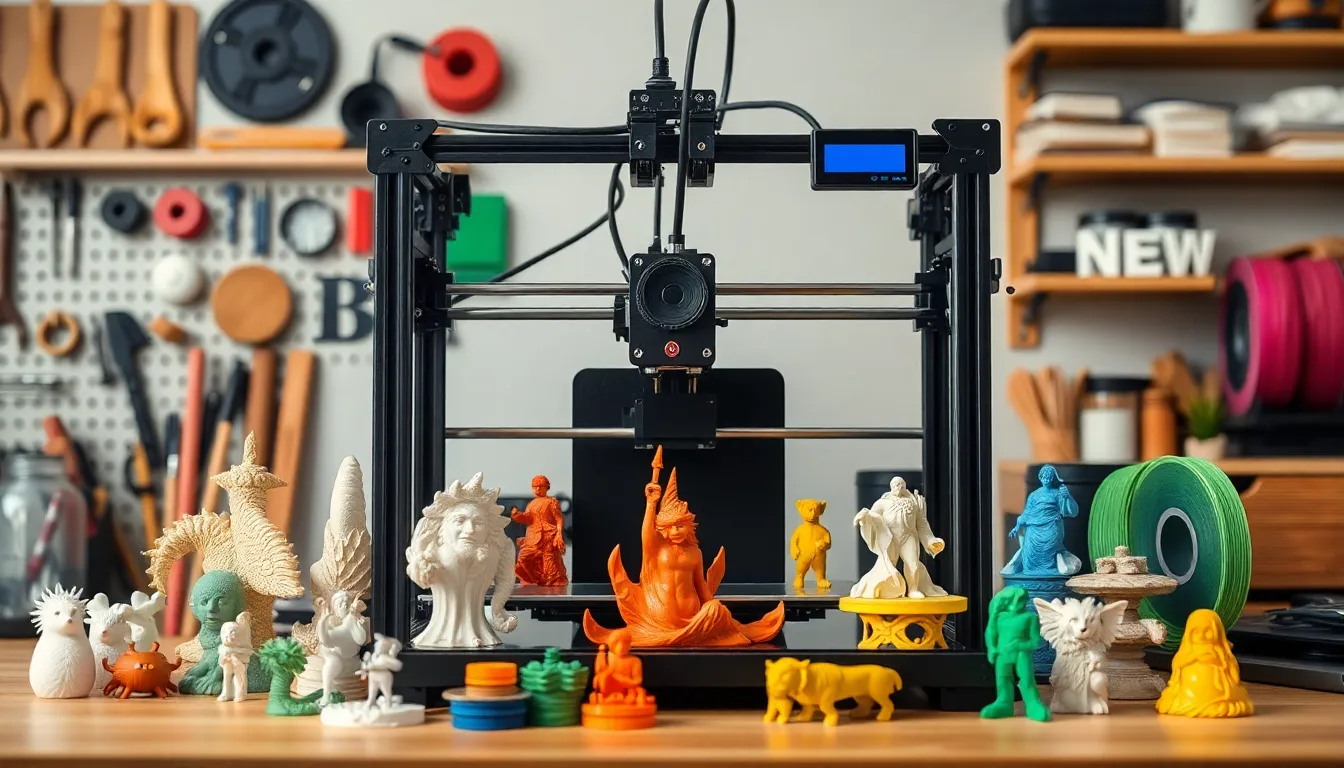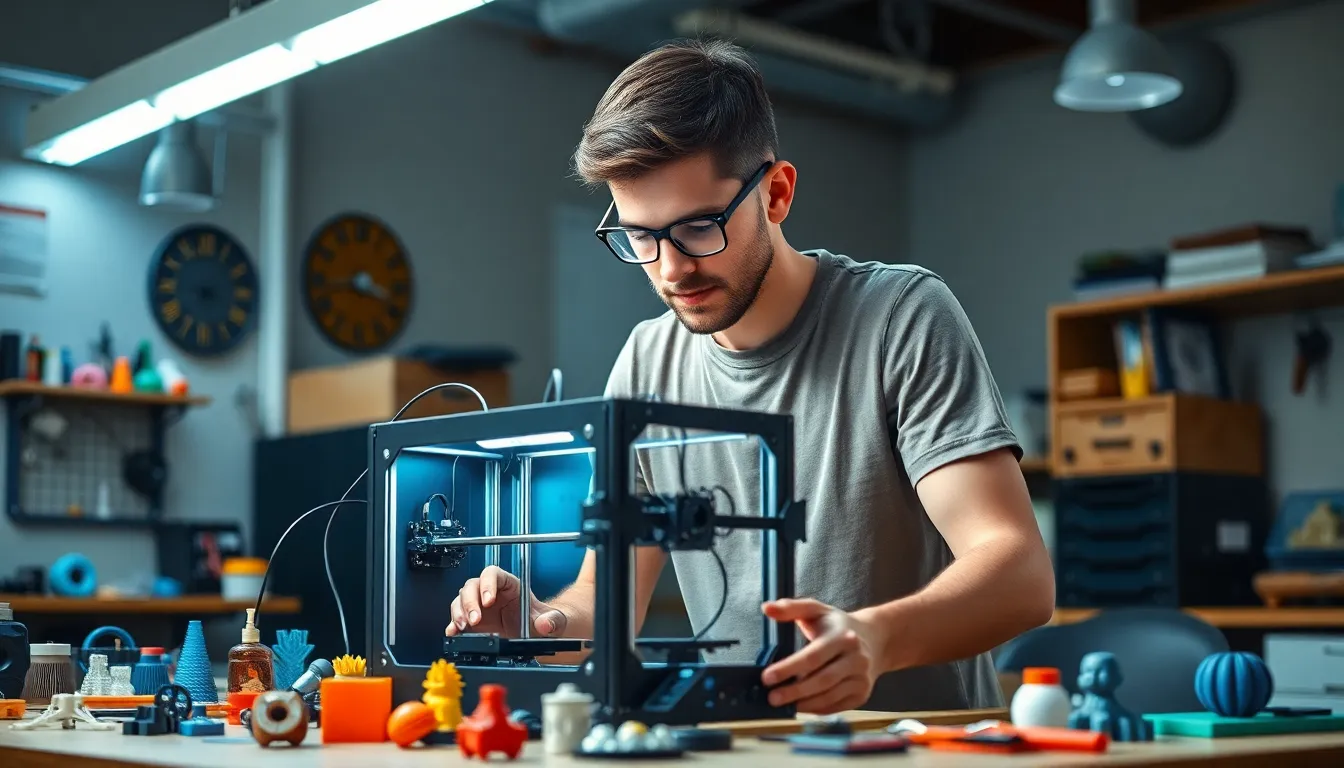In recent years, 3D printing has transformed from a niche hobby into a powerful tool for innovation and creativity. For enthusiasts and makers alike, a 3D printer kit offers an exciting way to dive into this revolutionary technology. These kits provide everything needed to build a 3D printer from scratch, allowing users to customize and understand the mechanics behind the process.
As the demand for personalized and unique creations grows, 3D printer kits have become more accessible and affordable. They cater to a wide range of skill levels, from beginners eager to learn to seasoned pros looking to expand their capabilities. With endless possibilities, the right kit can unlock a world of creativity, making it easier than ever to bring ideas to life.
Table of Contents
ToggleOverview of 3D Printer Kits
3D printer kits provide a hands-on approach to 3D printing. Users construct their printers from individual components, which enhances their understanding of the technology. These kits often include essential parts such as frames, motors, power supplies, and software.
3D printer kits come in various types to suit different skill levels.
- Entry-Level Kits: Designed for beginners, these kits feature straightforward assembly instructions and essential features. They often include all necessary components and basic software for easy setup.
- Intermediate Kits: Geared towards users with some 3D printing experience, these kits offer more advanced features like upgraded extruders and larger build volumes. They encourage users to explore customization options.
- Advanced Kits: Targeting experienced users, these kits include high-end components and require more complex assembly. They allow for extensive modifications, catering to specialized needs like multi-material printing.
3D printer kits are also widely available from various manufacturers. Popular brands include Creality, Prusa, and Anycubic. Each brand offers unique features and price points, catering to different preferences and budgets.
3D printer kits empower users to engage with 3D printing technology actively. They accommodate a range of skill levels and interests, promoting creativity and innovation in personal or professional projects.
Key Features to Consider

Selecting the right 3D printer kit involves several key features that impact performance and user experience. Evaluating these aspects ensures optimal functionality and satisfaction.
Build Size
Build size refers to the maximum dimensions of a printed object. Common sizes range from 120 x 120 x 120 mm to over 300 x 300 x 300 mm. Larger build sizes accommodate bigger projects and multiple smaller items in one print. Users need to consider their specific needs; those interested in miniatures may require smaller builds, while others pursuing larger prototypes benefit from expansive print areas.
Print Resolution
Print resolution determines the level of detail in printed objects, expressed in microns. Standard resolutions range from 50 microns for high detail to 300 microns for faster prints. Higher resolutions produce smoother surfaces and intricate designs, crucial for detailed models. Users should match their print resolution expectations with the printer kit’s specifications, as this can significantly affect the final outcome of their projects.
Compatibility with Filaments
Compatibility with filaments defines the materials a 3D printer kit can use. Common filament types include PLA, ABS, PETG, and TPU. PLA is user-friendly and ideal for beginners, while ABS offers durability and heat resistance suitable for functional parts. Advanced users may seek printers compatible with specialty filaments, such as nylon or composite materials. Evaluating filament compatibility ensures versatility for various projects and enhances the user’s creative possibilities.
Popular 3D Printer Kits
Various 3D printer kits cater to different skill levels and preferences. Below are popular categories that highlight key offerings in the market.
Entry-Level Kits
Entry-level kits provide a straightforward assembly experience, ideal for newcomers. These kits typically include essential components and clear instructions. They feature smaller build sizes, often around 200mm x 200mm x 200mm, allowing easy management for beginners. Notable examples include:
- Creality Ender 3: Known for its affordability and robust community support.
- Anycubic i3 Mega: Offers a touch screen interface and good print quality.
- Monoprice Select Mini V2: Compact design with pre-calibrated settings for immediate use.
These options help users grasp the fundamentals of 3D printing without overwhelming complexity.
Mid-Range Kits
Mid-range kits appeal to users with some experience, offering advanced features and more customization options. They typically have larger build sizes, ranging from 200mm to 300mm. Users benefit from improved print resolutions and more materials compatibility. Popular selections include:
- Prusa i3 MK3S: Renowned for its quality and ease of assembly, plus auto-bed leveling features.
- Artillery Sidewinder X1: Offers a silent stepper motor and direct drive extrusion for flexible filament use.
- Anycubic Chiron: Features a massive build volume and solid construction, suitable for larger projects.
These kits enhance creativity while still being user-friendly.
Professional Kits
Professional kits target experienced users and provide high-end features for demanding projects. They often boast substantial build sizes over 300mm, exceptional print resolutions, and advanced functionalities. Quality builds enable compatibility with a broader range of filaments and materials. Key models in this category are:
- Raise3D Pro2: Known for dual extrusion capabilities and extensive material compatibility.
- Ultimaker S3: Offers precision and reliability, along with user-friendly software.
- LulzBot TAZ Workhorse: Features an open-source design and customizable options for diverse printing needs.
These kits facilitate complex printing tasks and innovation in various professional applications.
Setting Up Your 3D Printer Kit
Setting up a 3D printer kit involves careful unboxing, assembly, calibration, and executing the first print. Each step requires attention to detail to ensure optimal functionality and performance.
Unboxing and Assembly
Unboxing a 3D printer kit starts with checking for all included components. Users should verify the contents against the provided list to avoid missing parts. Assembly typically involves following a detailed instruction manual, which often includes visual aids for clarity.
- Inspect all parts for damage.
- Organize components to streamline the assembly process.
- Secure the frame, ensuring all screws and bolts fit tightly.
- Connect the electronics according to the manual’s specifications.
- Attach the print bed and extruder as instructed.
- Perform a final inspection to confirm sturdiness.
Completing these steps accurately leads to a well-assembled machine ready for calibration.
Calibration and First Print
Calibration is vital for achieving the best print quality. Users should start with leveling the print bed, which ensures the correct distance between the nozzle and the surface.
- Follow the bed leveling process as outlined in the manual.
- Adjust settings for the Z-axis height to avoid nozzle clogs or poor adhesion.
- Set temperature parameters for the nozzle and bed based on filament type.
Once calibration is complete, users can execute the first print.
- Load the desired filament.
- Choose or upload a test print file, often a simple geometric shape.
- Start the print and monitor the initial layers for proper adhesion.
Successful calibration and the first print encourage further exploration of 3D printing capabilities.
Maintenance Tips for 3D Printer Kits
Regular maintenance ensures the longevity and performance of 3D printer kits. Implementing these practices keeps printers functioning optimally and enhances print quality.
Clean the Print Bed
Cleaning the print bed maintains adhesion and prevents print failures. Users should regularly remove residue and dust using isopropyl alcohol and a lint-free cloth. A clean surface promotes better first-layer adhesion.
Check and Tighten Belts
Checking and tightening belts prevents print inaccuracies and layer misalignment. Users should inspect belts for wear and tension every few prints. Adjusting the tension ensures smooth movement of the print head and maintains precision.
Lubricate Moving Parts
Lubricating moving parts reduces friction and wear, enhancing performance. Users should apply a suitable lubricant to lead screws and rods every few weeks to ensure smooth operation. Proper maintenance contributes to longevity and reliability.
Replace Worn Components
Replacing worn components is crucial for optimal performance. Users should regularly inspect parts like nozzles and bearings for wear. Changing out damaged components improves print quality and extends the lifespan of the printer kit.
Monitor Filament Quality
Monitoring filament quality impacts print results. Using high-quality filament reduces the risk of clogs and defects. Users should store filament in a dry environment and check for moisture before use to ensure consistent performance.
Update Firmware
Keeping firmware updated ensures the printer runs with the latest features and fixes. Users should regularly check for manufacturer updates and follow instructions for safe installation. Updated firmware often resolves bugs and improves functionality.
By following these maintenance tips, users can ensure their 3D printer kits perform reliably, producing high-quality prints while extending the life of their investment.
3D printer kits are transforming the way individuals engage with technology and creativity. They offer an exciting opportunity to learn and innovate while customizing devices to meet specific needs. As users explore various kits from entry-level to professional options, they can find the perfect fit for their skills and projects.
With a focus on hands-on assembly and maintenance, these kits foster a deeper understanding of 3D printing. By investing time in setup and care, users can unlock the full potential of their printers, leading to impressive results. Embracing this technology not only enhances personal creativity but also opens doors to new possibilities in design and production.




